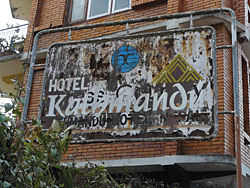 |
I live next door to the UNESCO Monument Zone of Patan Darbar Square. The neighbourhoods surrounding the palaces, temples and courtyards of this exemplar of Malla dynasty's golden age are a living, breathing blend of Newa commerce and culture more poised than the overrun sprawl of Kathmandu and the sterilised preservation of central Bhaktapur.
Yet I treasure the back gallis and bhattis of Mangal Bajar and Thaiti as much as I do the constantly evolving cast of restaurants and bars in the twin cities fronting the Bagmati. I appreciate the eclectic expression of western and Nepali cultures across the Valley as manifest in the galleries, concert halls and thoroughfares. I love the stray dogs dozing in the winter sun, the eagles wheeling across the blues skies, the obtuse bulls planted on city roads. And I couldn't do without the pockets of serenity around such indicators of the Valley's ancient history as Taudaha and Nagdaha, and the getaways stowed into the ridges and furrows of the guardian mountains ringing us.
After some time abroad, I've also come to the conclusion that this year's errant rains notwithstanding, the Kathmandu Valley has some of the best weather in the world. It's a privilege to share these mostly balmy climes with family, and friends old and new, Nepali and pharen. The longer I linger, the more I feel at home.
But as I crossed the Bagmati the other day, peering right into sewerside slum life, I was forced to ask myself: would I live here if I weren't Nepali, and hadn't grown up here?
The answer, I was surprised to learn, is no.
The whole of the Kathmandu Valley has been designated a World Heritage Site on account of our seven Monument Zones, but these cultural treasures are havens besieged by urban squalor. Traffic jams occupy the Valley's inhabitants, as garbage heaps do our stray dogs, eagles and holy cows. Sleazy dance bars and massage parlours constitute the Valley's chief entertainment, jazz and film festivals be damned, and proclaim their ubiquitous presence ever more boldly. There are precious few green or farming spaces left as the rush for unreal estate continues apace with the wholesale levelling of the natural landscape. It's a measure of how perverse the capital's living experience has become when it takes a bandh for us to reclaim our streets and breathe freely.
It's no use shuttling visitors to the Valley from one darbar square to another, one stupa to another, hoping they'll be blind to the incredibly offensive clanging clamour of our modern capital city. Rather, open your eyes to what we have become accustomed to. How casually we walk past an expanse of rotting garbage, how hopelessly we accept bandhs, how callously we flout traffic rules. How little we do to change things because we feel we can't change anything on our lonesome. How would the reality of Kathmandu appear to someone visiting for the first time?
It saddens me to concede that Kathmandu could really be Crapmandu, not Catmandoo. That the probability of my being here leans heavily on a certain nostalgia for times gone by and the ease of being 'from here'. But I'd like to think my being here also aspires to a revival and rejuvenation of those times we once knew, and a little more
than that.
Where then to start this new year and decade? There is so much at stake for the national polity in the months to come it may seem futile to imagine attracting state support. But not to imagine how to make the Kathmandu Valley livable again is even more so. The Nepali habit of evacuating bodily fluids into the environment may keep bodies clean, but transpose that philosophy to society at large and you get Kathmandu - spotless houses submerged in a sea of sewage.
We might start with a little civility on the streets of Kathmandu. When did honking ever clear a traffic jam? We might start with more responsible waste disposal. Compost your veggie waste if you have a garden, and cut down on plastic bags. We might start with neighbourhood organisation for better roads, better drains, better street lighting. But we have to start somewhere. If we don't, who will?



